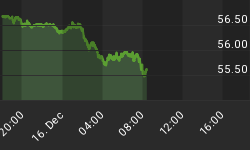The US trade deficit rose 2% to in December to $65.7 billion from a revised $64.7 billion (initial $64.2 billion) in November. Imports rose 1.9% to $177.2 bln -- while exports rose 2.1% to $111.5 billion.
For the year, the deficit grew 18% to an aggregate $726 billion, or 5.8% of GDP, from $618 bln or 5.3% of GDP.
The December figure was close to our for $66 bln forecast. The 5% decline in crude prices led to a 5% drop in imports of crude petroleum to $15.5 mln. The volume of crude oil imports fell 4%, registering the second monthly decline. Looking ahead, however, the 13% increase in crude prices in January (as measured by the West Texas Intermediate), followed by the 5% increase in December will probably lead to a rebound in oil imports back to the $25 billion mark. The 18% aggregate increased in oil imports over the 2 months could translate into an increase of at least 2% in overall imports, which is likely to maintain the trade imbalance at least atop the $65 bln figure.

The chart above shows that the US bilateral deficit improved with major trading partners in the month ending in December with the exception of Canada, where the deficit rose 5% to $8 bln. The trade gap fell 12%, 7%, and 2% with China, Japan and the Eurozone to $16.3 bln, $6.8 bln and $7.5 bln respectively.
The picture looks less bright a 12-month basis as the trade deficit fell with all the major trading partners, with the exception of the UK.
The energy bill is prominently displayed (see yellow circles) through the 33% and 29% increase in trade deific with Canada and Mexico in the 12 month period ending December 2004.
But US Trade Gap Remains Well Financed
Despite the swelling in the trade gap to a new record high, 2005 demonstrated to show no faltering in the net capital inflows, which are estimated at $931 billion in 2005 (based on our estimate for December), or 7.5% of GDP. As the chart shows below, the 7.5% of GDP is a sufficiently plentiful coverage of the annual trade deficit which amounted to 5.8% of GDP.
Nonetheless, as we have long pointed out the increase purchasing of US debt by private flows -- which usually comprise Caribbean center-registered entities, i.e. hedge funds. Much ink has been spilled about foreign demand for US Corporates making up about 40% of total net foreign inflows into US stocks and bonds in the first 10 months of last year.
The prospects for continued foreign inflows may have improved after the re-introduction of the 30-year bond, which even though will exacerbate the budget deficit, is expected to channel a new source of USD-bound flows. This is especially essential considering the slowing pace into US treasuries and the volatile pace of foreign flows into US equities.

Next week's action will be largely dominated by Fed Chairman Bernanke's Congressional testimony, which we expect to sound off the usual upbeat assessment on the economy from the Fed that should maintain the 90% probability of a March rate hike. Of equal importance, will be the Q&A session, which will give us the chance to see a less prepared Bernanke as he gives non-scripted answers. Although we see a high chance of hawkish rhetoric next week, we still believe that the progression of the data over the next 5 weeks could sway the Fed to reconsider a tightening given the monetary policy tightening, rising energy costs and the deepening inversion of the yield curve.
But this is not causing us to issue any bearish dollar forecasts just yet. We believe that even if Bernanke's Fed feels it is the time to stop raising rates, it will not issue a widely telegraphed message to the markets in order to avoid further decline in long yields and risk renewed advances in housing prices. Yet, it's worth noting that a telegraphed "rate hold" could also lead to inflation nervousness among bond traders, especially as headline inflation risks spilling onto core inflation later in the year when the Fed will have no choice but having to bring the tightening to an end.
February 2006 FX Forecast
| Current Rate* | End of Feb 2006 | End of Apr 2006 | End of Jul 2006 | End of Jan 2007 | |
| EUR/USD | 1.1955 | 1.2030 | 1.2250 | 1.2400 | 1.2600 |
| USD/JPY | 119.00 | 117.50 | 115.00 | 113.00 | 109.00 |
| GBP /USD | 1.7452 | 1.7620 | 1.7850 | 1.8100 | 1.8500 |
| USD/CHF | 1.3024 | 1.2950 | 1.2700 | 1.2450 | 1.2200 |
| USD/CAD | 1.1459 | 1.1320 | 1.1300 | 1.1100 | 1.100 |
| AUD/USD | 0.7420 | 0.7500 | 0.7550 | 0.7620 | 0.7700 |
| CNY /USD | 8.06 | 8.05 | 8.05 | 8.03 | 8.01 |
















